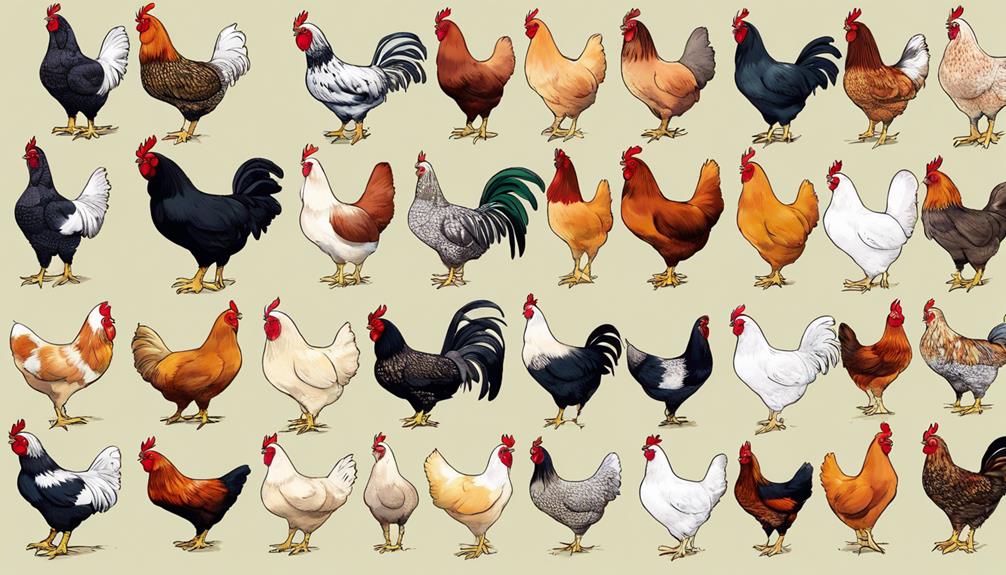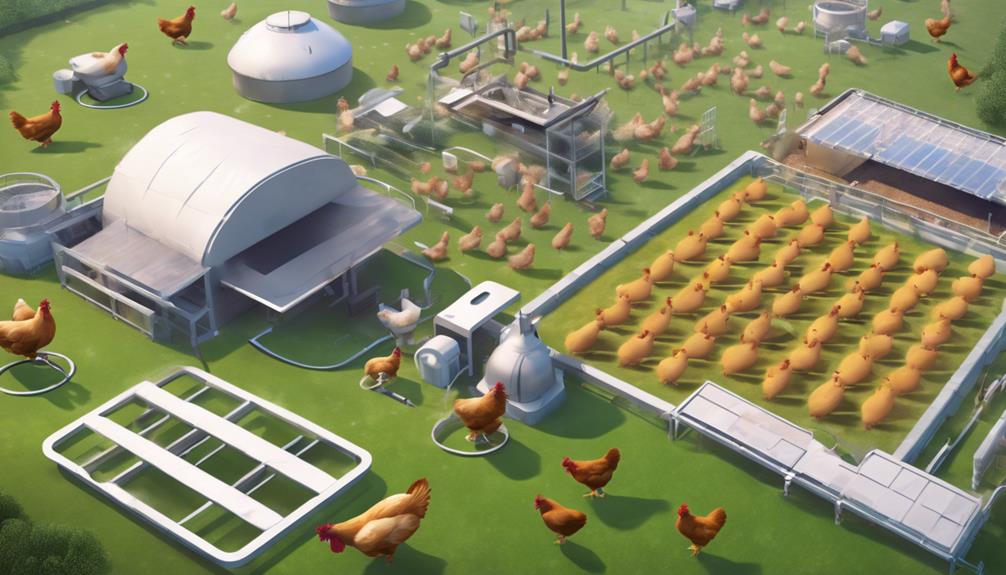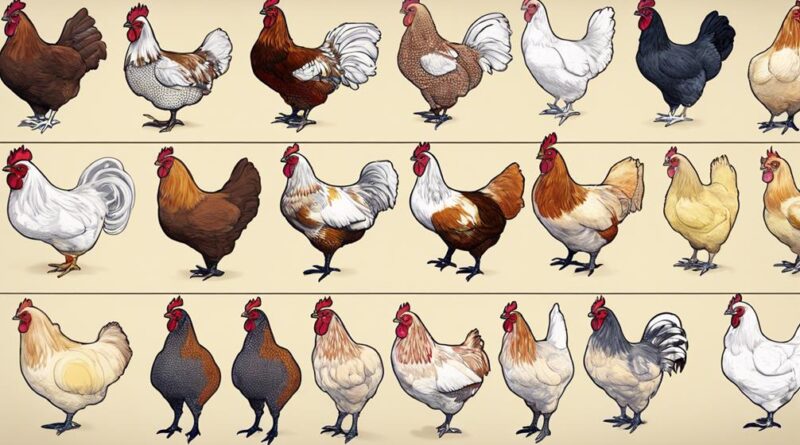Top 10 Advances in Poultry Genetic Selection"
Explore Marker-Assisted Selection and Genomic Selection for precise breeding. Optimize with broiler and layer breeding programs. Develop parental lines for growth and disease resistance. Preserve genetic diversity using embryo sexing technologies. Utilize AI and machine learning for precise trait selection. Discover how these advancements are revolutionizing poultry genetic selection.
Marker-Assisted Selection
Marker-Assisted Selection enhances poultry breeding efficiency by utilizing genetic markers to predict and select for desirable traits with precision and accuracy. This method revolutionizes the breeding process by identifying specific genetic markers associated with traits like disease resistance, growth rate, and egg production. Genetic marker discovery plays a crucial role in this process, as researchers pinpoint markers linked to favorable characteristics to accelerate the breeding of healthier and more productive poultry.
When it comes to poultry health, Marker-Assisted Selection offers a proactive approach by enabling breeders to select birds with a lower susceptibility to diseases. By incorporating genomic advancements, such as next-generation sequencing and high-throughput genotyping, breeders can analyze an extensive number of genetic markers efficiently. This advanced technology allows for a more comprehensive understanding of the genetic makeup of poultry populations, leading to more informed breeding decisions.
Genomic Selection
Utilizing genomic information for selective breeding in poultry allows breeders to predict and enhance desirable traits with unprecedented accuracy and efficiency. Genomic selection involves the analysis of an individual's entire genome to identify genetic markers associated with specific traits of interest. Through advancements in genomic sequencing technologies, breeders can now obtain detailed information about an organism's genetic makeup, enabling more precise selection decisions. By incorporating genomic data into breeding strategies, such as genotype imputation and genomic estimated breeding values (GEBVs), breeders can accelerate genetic progress by identifying superior individuals for breeding purposes.
Genomic sequencing plays a crucial role in genomic selection by providing a comprehensive view of an individual's genetic composition. This information allows breeders to identify key genetic markers linked to traits like disease resistance, growth rate, egg production, and feed efficiency. By analyzing these markers, breeders can make informed decisions about which individuals to select as parents for the next generation, ultimately leading to the development of poultry with improved performance and health.
Breeding strategies in genomic selection focus on maximizing genetic gain while minimizing the generation interval. By selecting individuals based on their GEBVs, breeders can optimize the genetic potential of the offspring, leading to more productive and resilient poultry populations. Additionally, genomic selection enables breeders to overcome challenges such as long generation intervals and expensive phenotyping, making genetic improvement more cost-effective and efficient.
Parental Line Development
Developing robust parental lines in poultry breeding involves strategic selection of individuals with superior genetic traits to establish a solid foundation for future breeding programs. Genetic improvement strategies are crucial in this process. Breeding objectives must be clearly defined to guide the selection of parent stock. These objectives often include traits such as growth rate, feed efficiency, disease resistance, and egg production.
Selection methods play a key role in parental line development. Traditional methods involve phenotypic evaluations, where individuals are assessed based on observable characteristics. However, with advancements in technology, genetic markers linked to desirable traits are now used for more precise selection.
Performance evaluation is essential to ensure the effectiveness of the selected parental lines. This involves monitoring traits of interest in the offspring produced by the selected parents. By analyzing the performance of these offspring, breeders can adjust their selection criteria to continuously improve the genetic potential of the parental lines.
Broiler Breeding Programs
In broiler breeding programs, genetic selection plays a crucial role in enhancing desirable traits for optimal meat production. The main focus of broiler breeding programs is on improving feed efficiency optimization and selecting genetic traits that promote rapid growth rates.
To achieve feed efficiency optimization, breeders utilize advanced genetic selection techniques to identify and enhance genes associated with efficient feed conversion. This process involves analyzing the heritability of feed efficiency traits and selecting parent birds with superior genetic markers to pass on to the next generation. By continually selecting for improved feed efficiency, broiler breeding programs can reduce production costs and environmental impact while maximizing meat output.
Growth rate improvement is another key aspect of broiler breeding programs. Through meticulous breeding program analysis, breeders can identify and select birds with genetic predispositions for rapid growth. By focusing on traits such as muscle development, metabolism, and overall health, breeders can accelerate the growth rates of broilers without compromising their welfare. This targeted approach results in broilers reaching market weight faster, leading to increased efficiency in meat production.
Layer Breeding Innovations
Innovations in layer breeding practices have revolutionized the poultry industry's approach to genetic selection for egg production efficiency. Through meticulous breeding strategies, significant advancements have been made in enhancing egg quality and reproductive efficiency in layers.
Egg quality improvements have been a focal point in recent breeding innovations. Selection criteria now include traits such as shell strength, yolk color, albumen consistency, and overall egg size uniformity. By selectively breeding layers with desirable egg quality attributes, producers can ensure a consistent supply of high-quality eggs to meet consumer demands.
Reproductive efficiency enhancements have also played a crucial role in optimizing layer breeding programs. Genetic selection now targets traits related to egg production rate, egg size, age at sexual maturity, and overall reproductive longevity. These improvements not only increase the number of eggs laid by each hen but also extend their productive lifespan, resulting in a more sustainable and cost-effective production system.
Disease Resistance Enhancement
Layer breeding advancements have set the stage for further progress in enhancing poultry genetic selection, particularly in the realm of Disease Resistance Enhancement. Improving disease resistance in poultry is crucial for sustainable production. To achieve this, various strategies focusing on immunization, genetic modification, antibiotic alternatives, and immune system activation have been implemented.
Immunization strategies play a vital role in enhancing disease resistance in poultry. By vaccinating birds against specific pathogens, breeders can reduce the likelihood of infections spreading through flocks. Additionally, genetic modification techniques have been explored to develop poultry breeds with inherent resistance to certain diseases. Through selective breeding and genetic engineering, chickens with improved disease resistance traits can be produced.
In light of increasing concerns about antibiotic resistance, finding alternatives to antibiotics in poultry production is paramount. One approach is to enhance the birds' immune systems through proper nutrition and management practices. By boosting the immune response, chickens can better fend off pathogens without the need for antibiotics, ultimately contributing to healthier flocks and safer poultry products.
Genetic Diversity Preservation

Preserving genetic diversity in poultry populations is a critical aspect of maintaining long-term sustainability and resilience within breeding programs. Genetic diversity management is essential to prevent the loss of valuable traits and to ensure that populations remain adaptable to changing environmental conditions and emerging diseases. By maintaining a diverse gene pool, breeding programs can reduce the risks associated with inbreeding depression and increase the overall fitness of the population.
Effective genetic diversity preservation strategies involve careful selection of breeding individuals to maximize the representation of different genetic lines. This can be achieved through the use of advanced genomic tools that allow breeders to assess the genetic relatedness between individuals and make informed decisions to maintain diversity. Additionally, implementing structured breeding programs that prioritize genetic variation can help safeguard against the loss of rare alleles and unique genetic combinations.
Breeding program sustainability hinges on the successful management of genetic diversity. Without adequate measures in place to preserve genetic variation, populations may become more susceptible to diseases and other stressors, ultimately compromising the overall productivity and health of poultry stocks. Therefore, ongoing efforts to monitor and enhance genetic diversity are crucial for the long-term success of poultry breeding programs.
Embryo Sexing Technologies
Utilizing cutting-edge techniques, poultry breeders are increasingly turning to advanced embryo sexing technologies to enhance breeding efficiency and genetic selection processes. Gender selection through embryo sorting has revolutionized the poultry industry by allowing breeders to choose the sex of the chicks even before they hatch. This technology enables breeders to focus their resources on developing the desired gender for specific breeding purposes, such as increasing egg production or improving meat quality.
Embryo sexing technologies involve the use of specialized equipment like high-resolution microscopes and molecular tools to identify and separate male and female embryos. By accurately determining the gender of the embryos early in the development process, breeders can make informed decisions regarding which embryos to implant or hatch, leading to more efficient breeding programs.
The ability to selectively breed for certain traits in male or female chicks has significant implications for genetic selection. Breeders can now optimize their breeding strategies by targeting specific genetic traits in each gender, ultimately improving the overall quality and productivity of their poultry stock. Additionally, embryo sexing technologies help reduce the number of male chicks that are typically culled in the poultry industry, leading to more ethical and sustainable breeding practices.
AI and Machine Learning Applications

Incorporating AI and machine learning applications into poultry genetic selection processes can revolutionize breeding strategies and enhance the precision of genetic trait optimization. AI optimization techniques leverage vast amounts of data to identify complex patterns that may not be apparent through traditional analysis methods. By utilizing machine learning algorithms, breeders can predict and select for desired traits more accurately, leading to accelerated genetic progress.
AI optimization in poultry genetic selection involves the use of algorithms to analyze genetic data and make predictions about traits of interest. Machine learning algorithms, such as neural networks and decision trees, can sift through massive datasets to identify correlations between genetic markers and specific traits. This allows for the creation of more targeted breeding programs that focus on enhancing desirable characteristics while minimizing the expression of undesirable ones.
Moreover, AI can facilitate the identification of novel genetic markers associated with important traits, providing valuable insights for future breeding efforts. By continuously learning from new data, machine learning algorithms improve their predictive capabilities over time, leading to further enhancements in genetic selection accuracy. The integration of AI and machine learning technologies into poultry breeding programs represents a significant advancement that holds great promise for the future of genetic selection in the poultry industry.
Precision Breeding Techniques
Precision breeding techniques in poultry genetic selection require meticulous attention to detail and a strategic focus on optimizing specific genetic traits. One of the key advancements in this field is the utilization of CRISPR gene editing. CRISPR allows for precise modification of the poultry genome, enabling targeted changes in genes associated with desirable traits such as disease resistance, growth rate, and egg production.
By incorporating CRISPR gene editing into the breeding process, poultry breeders can expedite the development of genetically superior bird populations. This technology enhances the selection accuracy by directly modifying the genes responsible for the desired characteristics. As a result, the breeding programs become more efficient and effective in producing birds with the desired traits.
Moreover, precision breeding techniques contribute to significant improvements in selection accuracy. Through the precise manipulation of genetic material, breeders can select for specific traits with higher confidence levels. This increased accuracy leads to the development of poultry populations with enhanced genetic potential, ultimately benefiting both producers and consumers.
Frequently Asked Questions
How Do Ethical Considerations Impact Poultry Genetic Selection Advancements?
When considering poultry genetic selection advancements, ethical implications play a crucial role in decision-making. Animal welfare should be at the forefront of these advancements to ensure that genetic selection practices prioritize the well-being of the poultry population.
By incorporating ethical considerations into genetic selection processes, breeders can uphold standards that promote the health and quality of life of the animals involved.
This approach fosters responsible and sustainable practices within the poultry industry.
What Are the Potential Environmental Impacts of Intensive Genetic Selection in Poultry?
When intensive genetic selection is applied in poultry farming, environmental consequences can arise. Sustainability concerns may stem from reduced genetic diversity, leading to a higher risk of disease outbreaks and decreased resilience to environmental changes.
Additionally, intensive selection for specific traits may result in unintended negative impacts on the ecosystem. Careful monitoring and management practices are essential to mitigate these potential environmental impacts and ensure the long-term sustainability of poultry genetic selection.
Are There Any Regulatory Challenges Associated With Implementing Advanced Genetic Selection Techniques in Poultry?
When it comes to implementing advanced genetic selection techniques in poultry, you may encounter regulatory challenges and ethical considerations. These hurdles can stem from issues like genetic modification regulations, animal welfare concerns, and consumer acceptance.
It's crucial to navigate these obstacles with caution and ensure that any genetic selection practices align with legal requirements and ethical standards. By addressing regulatory challenges proactively, you can help pave the way for responsible and sustainable genetic selection practices in the poultry industry.
How Do Cultural Preferences Influence the Direction of Poultry Genetic Selection Programs?
Cultural influences play a significant role in shaping the direction of poultry genetic selection programs. Different regions have varying preferences for traits like taste, appearance, and production efficiency, driving breeders to focus on specific characteristics.
However, these cultural preferences can also lead to ethical dilemmas, such as prioritizing certain traits over animal welfare. Balancing these factors is crucial in designing effective and socially acceptable genetic selection programs for poultry.
What Role Do Consumer Demands Play in Shaping Genetic Selection Priorities in the Poultry Industry?
Consumer preferences and market demands are crucial factors influencing genetic selection priorities in the poultry industry. Understanding what consumers want in terms of taste, nutrition, and ethical concerns guides breeders in developing poultry with desired traits.
Conclusion
In conclusion, the top 10 advances in poultry genetic selection have revolutionized the industry by enhancing breeding efficiency, genetic diversity, and overall bird performance.
Marker-assisted selection and genomic selection have paved the way for precise breeding strategies, while innovations in parental line development and broiler breeding programs have resulted in superior meat quality and growth rates.
With the incorporation of AI, machine learning, and precision breeding techniques, the future of poultry genetic selection is promising and continuously evolving.
